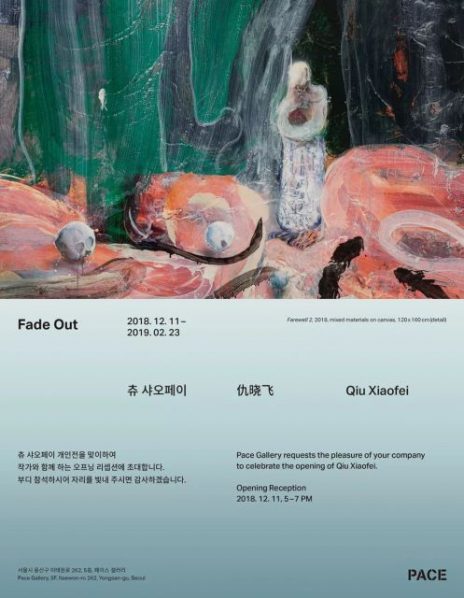
Pace Gallery announces Fade Out, a solo exhibition of work by Chinese artist Qiu Xiaofei. Qiu held his first Korean exhibition at Seoul’s Doosan Art Center in 2009. Now, a decade later, the artist will display a new series of work through which he has continued his exploration and contemplation of the art of painting.
A representative figure of China's New Generation artists, Qiu Xiaofei takes a cognitive approach to painting, focusing on the effects that color and visual images have on the mind and consciousness. Unlike other recent exhibitions of the artist’s work, Fade Out is a structured presentation: four gray-green toned oil paintings, placed among several small-format landscapes and works on paper, are arranged along six powder blue walls, the color of which gradually deepens as if the light is slowly moving across the space. Two pieces, Farewell 1 and Farewell 2, occupy the focal point of the exhibition hall; in these paintings, enigma-like figures and landscapes emerge from the gloom.
The small landscape paintings interspersed between them, Evening Mist and Afterglow, provide viewers with anchor points for mood, and also hint at the sunlight’s gradual retreat. By repeatedly working on the identical compositions in Constancy and Impermanence #1, a suite of works on paper, Qiu drapes a tone of changing time over his imaginary and fantastical scenes. This working method conjures up thoughts of Monet’s Rouen Cathedral series. However, in this series, the artist uses ephemeral imagery of the unconscious as constant figures. The entire exhibition is akin to the end of a silent movie played in a constant loop; amid this gradual and cyclical fade to darkness, these paintings seem to be flickering fragments of memory.
Qiu’s new works reveal further reflection toward images and the language of painting, evoking not only the prolonged discussion of representation, but also a more conscious initiative: to awaken the potential of human perception hidden in the depths of the mind. It is not hard to recognize another thread woven throughout this exhibition: time, being prompted by the intentional movement of light in the space, and the literal meaning of the phrase Fade Out. Consider the artist’s immediate experience with the gradual passage of time in his daily life. In an experience like this, the painter is no longer depicting objective things, but rather retreating into a part of life and nature together with the act of painting. This also transforms the site of the exhibition into a synchronic field, where the artist hopes to establish a more equal relationship of communication, connection, and coexistence between himself and the audience, as well as among the audience itself. It attempts a new form of group relation, which relies on humanity’s eternal puzzlement over the notion of time and on humanity’s innate sensibility and imagination, referring to a direct perceptual experience and synesthetic physical resonance through painting.
In this fragmented cyber age that has lost its sense of wholeness, Qiu’s work strives to portray the ineffable. It is indeed in this regard that painting as a time-honored human activity still maintains its pioneering nature today.
About the artist
Qiu Xiaofei's (b. 1977, Harbin, China) artistic practice includes oil painting, watercolor, drawing, sculpture and installation. The concept of his work engages relationships between personal experience and history. Recently, his work focuses on the psychological state during the creative process. Qiu Xiaofei’s artworks evoke a dreamlike state. Many of his paintings are based on photos from his childhood. His current multi-disciplinary work combines drawings with sculptures and act as a chronological recorder of the artists’ history. As he explores various parts of his memory or “thought diversions” as Qiu Xiaofei calls them, they allow him to delve deeper into his “procedural, subconscious and personal experiences.”
About the exhibition
Dates: Dec 12, 2018 – Feb 23, 2019
Venue: Pace Gallery, Seoul
Tel: +82 70 7707 8787 Tue-Sat 11-7




























